Installation
Comodo Client Security (CCS) provides best-in-class threat prevention for Linux endpoints. The product is part of Comodo Endpoint Manager and is deployed from the Endpoint Manager console.
This section covers how to:
Subscribe for Endpoint Manager
- Dragon - Sign up for Dragon at https://platform.comodo.com/signup
- Comodo One - Customers who already purchased Advanced Endpoint Protection (AEP) licenses from Comodo or its resellers can sign-in to C1 at https://one.comodo.com/app/login
- Use your username / password of your Comodo account created during purchase of AEP licenses
- Set-up your C1 MSP / Enterprise account
- After sign-up, login to the portal then click 'Applications > 'Endpoint Manager'
- Visit https://secure.comodo.com/home/purchase.php?pid=98&license=try for the trial version or https://secure.comodo.com/home/purchase.php?pid=98 for the full version.
- After sign-up, you can access your Endpoint Manager at the URL provided during setup.
You
must add users to Endpoint Manager before you can install CCS on your
endpoints.
- Dragon MSP / C1 MSP customers - You can create multiple companies and enroll users to any of them.
- Dragon Enterprise / C1 Enterprise, and stand-alone Endpoint Manager customers - All users are enrolled to the default company.
Add a user
- Open Endpoint Manager
- Click 'Users' > 'User List'
- Click 'Create User'
or
- Click
the 'Add' button
 on the menu bar and choose 'Create User'.
on the menu bar and choose 'Create User'.
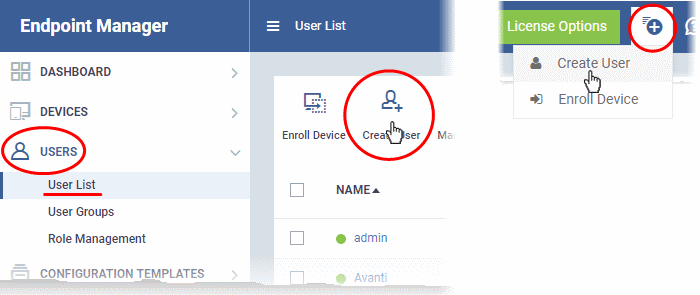
The create user form will open:
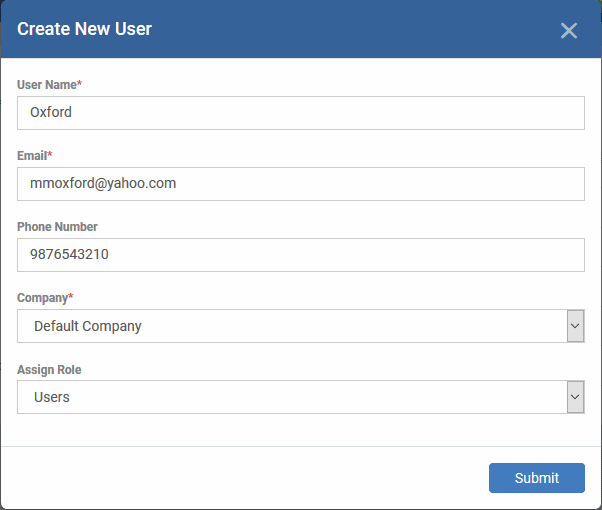
- User Name - Enter the login username of the user. They will appear under this name in the EM interface.
- Email - Account and device activation mails will be sent to this address.
- Phone Number - The contact number of the user.
- Company - The organization to which you want to add the user.
-
Role
A 'role' determines user permissions within the Endpoint Manager console itself. Endpoint Manager ships with two default roles:
- Administrator - Full privileges in the Endpoint Manager console. The permissions for this role are not editable.
- User - In most cases, a user is simply an owner of a managed device. They should not require access to the Endpoint Manager console. Under default settings, users cannot login to Endpoint Manager.
- Click 'Submit' to add the user to Endpoint Manager.
A confirmation message is shown:
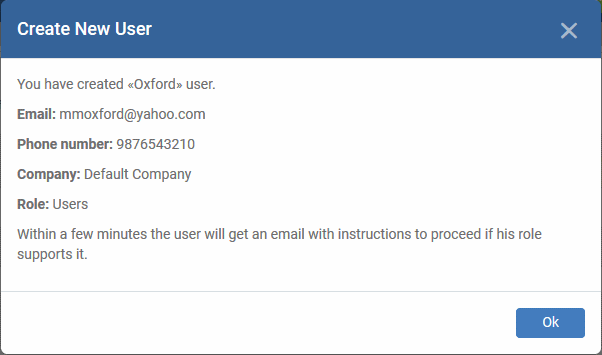
- Repeat the process to add more users
- New users are added to the 'Users' interface (click 'Users' > 'User List')
|
Tip: You can also bulk import users from a .csv file. Seehttps://help.comodo.com/topic-399-1-786-12973-Import-Users-from-a-CSV-File.htmlfor more details. |
The next step is to add user devices so you can manage them with Endpoint Manager.
- Click 'Users' > 'User List'
- Select users for whom you want to enroll devices
- Click the 'Enroll Device' button above the table
Or
- Click
the 'Add' button
 on the menu bar and choose 'Enroll Device'.
on the menu bar and choose 'Enroll Device'.

This starts step 1 of the device enrollment wizard:
Step 1 - Device Options
- Current device - Enrolls the device you are currently using. You may disregard this option at this stage as we are adding multiple devices with the 'Other device' option.
- Other device - Add devices owned by the users you selected previously. Those users should already be listed in the 'Specify User' box:
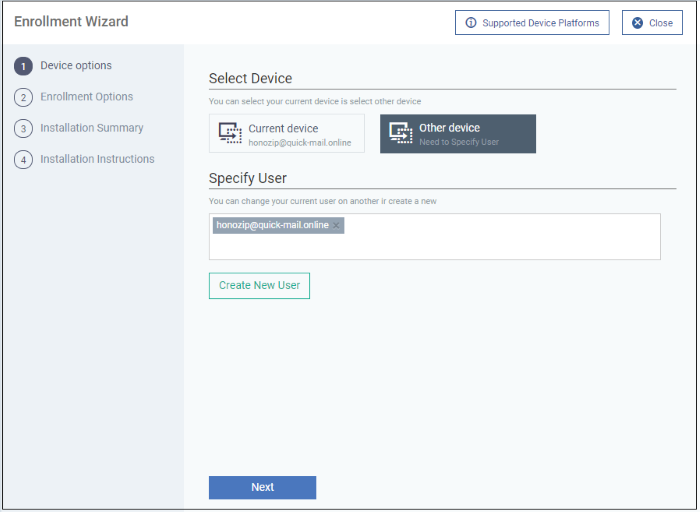
- You can add additional, existing users by simply typing their email address in the box. Endpoint Manager will auto-suggest users that have already been created.
- Create New User - Click if you want to add a new user to Endpoint Manager. You cannot add devices unless you have first added the users that own them.
- Click 'Next' to proceed to step 2.
Step 2 - Enrollment Options
Enrollment Type
Applies to Windows, Mac and Linux devices.
- Enroll and Protect - Installs both the communication client and the security client.
- Just Enroll - Installs only the communication client
Background. There are two types of client:
- Communication Client - Connects the device to Endpoint Manager for central management. It is mandatory to install this client.
- Security Client - This is the security software. Depending on the operating system, it includes antivirus, firewall, threat-containment, web-filtering, and more. It is optional to install this client.
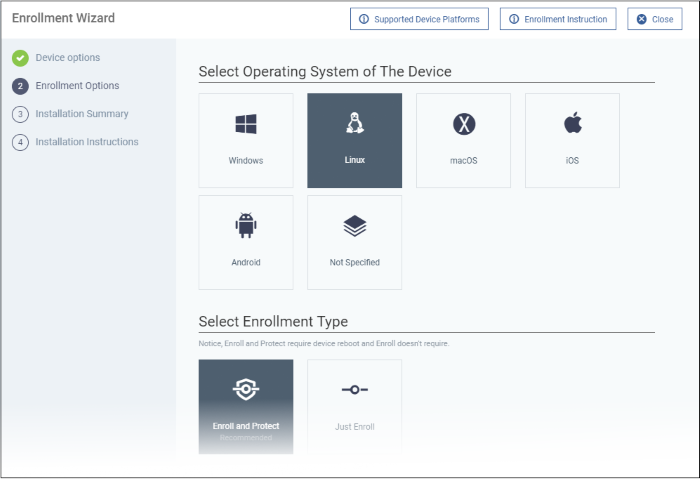
TLDR - ‘Not specified’ only installs the communication client so the device can connect to Endpoint Manager. It does not install the security client. Click one of the operating system tiles if you also want to install the security client.
Option 1 - Enroll + Protect - Single Operating System
- Choose this if you want to deploy both communication and security clients
- Click the Linux OS box. Please make sure all your target devices use this operating system.
- The wizard will send enrollment mails which only contain download links for the Linux clients.
- You can customize enrollment options as required. You can configure items such as enrollment type, Linux OS version and device name.
- Note - Please uninstall any other antivirus products from target endpoints before proceeding. Failure to do so could cause conflicts that mean CCS does not function correctly.
Option 2 - Enroll Only - Multiple Operating Systems
- Choose this if you only want to deploy the communication client. If required, you can install the security client later after enrolling the endpoint
- Click 'Devices' > 'Device List'
- Select the target devices
- Click the 'Install or Update Package' button > Choose 'Install Comodo Client – Security'.
Click 'Next' to skip to step 3 if you are happy with your choices thus far.
OR
See the table below for more information about the options on this page.
|
Setting |
Description |
|---|---|
|
Select Method |
Select Linux OS version
|
|
Device Name Options |
|
- Click 'Next' to proceed to step 3
Review your choices so far.

- Click ‘Back’ or 'Change Configuration' (top-right) to revise your choices.
- Click 'Next' to proceed to step 4
Step 4 - Installation Instructions
The final step is to send out the enrollment emails to the device owners:
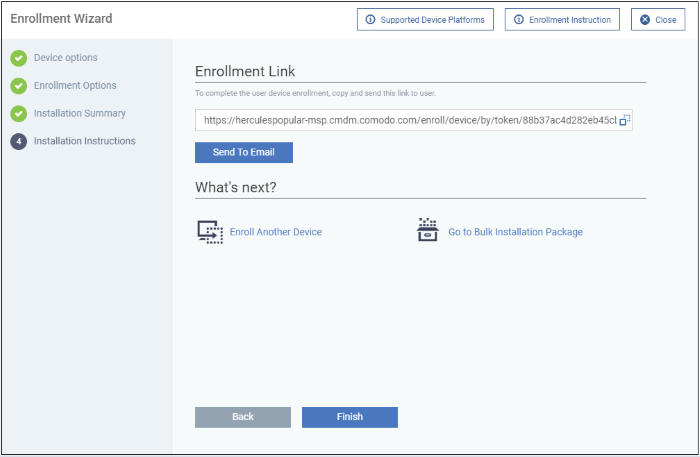
- Send To Email - Click this to send enrollment mails to users with the settings you choose in steps 1 - 3.
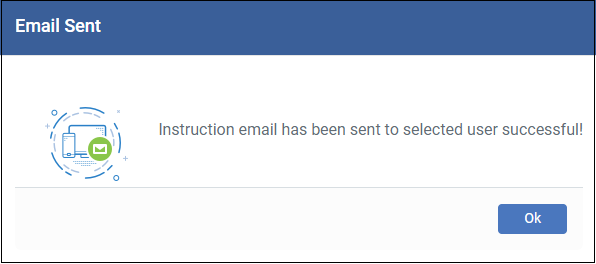
- Enroll Another Device - Takes you back to step 1
- Go to Bulk Installation Package - Takes you to bulk installation package screen to configure and enroll users in bulk. See 'Bulk Enrollment of Devices'
- Click 'Finish' to close the window.
An example mail is shown below:

The user experience is as follows:
- User opens the email on the Linux endpoint you want to enroll.
- Click the enrollment link in the email to open the device enrollment page
- Click the 'Download Linux Installer' button:
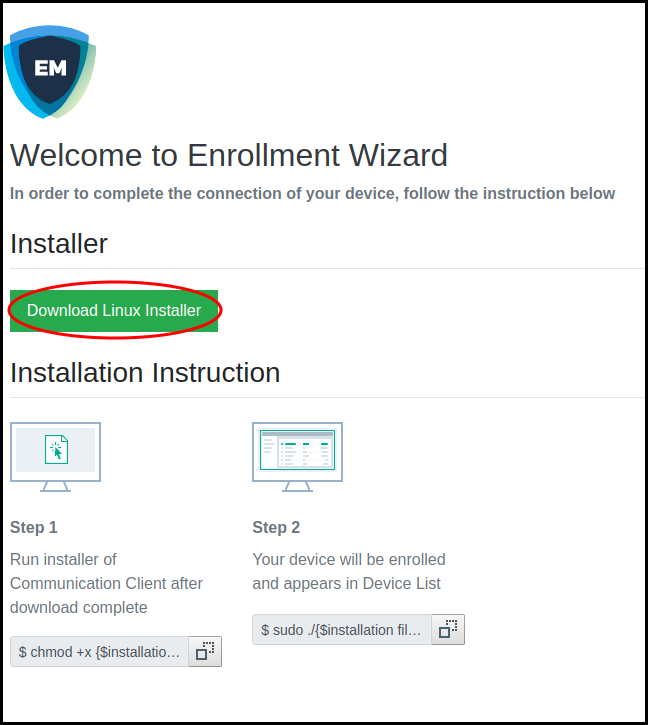
You can install the communication client on the Linux device by completing the following:
-
Change installer mode to executable - enter the following command:
$ chmod +x {$installation file$}
-
Run installer with root privileges - enter the following command:
$ sudo ./{$installation file$}
For example:
chmod +x itsm_cTjIw6gG_installer.run
sudo./itsm_cTjIw6gG_installer.run

- After
installation, the communication client will connect to the Endpoint
Manager and enroll the device. The EM communication client icon
 appears at the
top-right of the endpoint screen.
appears at the
top-right of the endpoint screen.
- Protection is effective immediately after the computer restarts.
An Endpoint Manager (EM) security profile is applied to the device.
- If the user is already associated with a configuration profile in EM, then those profiles will be applied to the device. See Assign Configuration Profile(s) to User Devices and Assign Configuration Profiles to a User Group for more details.
- If no profiles are defined for the user then the default Linux profile(s) will be applied to the device. See Manage Default Profiles for more details.
The
device can now be remotely managed from the EM console.



